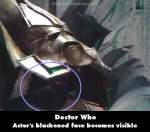The Dalek Invasion of Earth - S2-E2
Trivia: The plot of this Doctor Who story was adapted and remade by Hammer Films into a full blown cinema release, Dalek Invasion Earth 2150AD, which was released in 1966 and starred Peter Cushing as a human actually named "Doctor Who." The major change in the plot was to redate the story from 2164AD to 2150AD.
The Greatest Show in the Galaxy - S25-E4
Trivia: For a show with a "Circus and Clowns" theme, it is appropriate that this Doctor Who story was filmed in a tent. It wasn't planned that way, but the studio at BBC TV Centre in London that was originally to be used for filming "The Greatest Show in the Galaxy" had to be closed at short notice when the presence of dangerous white asbestos was discovered in the studio's structure. With no alternative studios available, filming was switched to a marquee temporarily erected in the car park of the BBC Studios at Elstree.
Trivia: Location filming of "The War Games" took place in East Sussex during April 1969. To depict the desolate landscape of "no-man's land" during 1917, the location shoot was done at the Brighton Corporation Refuse Tip at Sheepcote, near Brighton. The very same location had been used just a few months before, also to depict "no-man's land in 1917" by Richard Attenborough, for his film Oh What A Lovely War.
The Daleks' Master Plan - S3-E4
Trivia: A "missing, believed wiped" episode was found in January 2004, when "Day of Armageddon", the second episode of "The Daleks' Master Plan", was returned to the BBC by an employee of Yorkshire Television. He had rescued the print from destruction in the early 1970s when, as a young BBC engineer, he had found it in a room at the BBC's Ealing Film Studios, which he had been asked to clear of rubbish. He disobeyed the instruction to destroy the episode and took it home with him. Arguably, he stole it from the BBC, but if he hadn't, it would never have survived. In 2013 (I forgot the episode name, but it was the one with Salamander), they found the rest of the films for another episode. The new ones were animated, combined with the already existing ones and released on DVD.
Trivia: In 1972, the BBC began a "purge" of its archives to save costs, and amongst the shows selected for disposal were all 268 black-and-white episodes of Doctor Who first broadcast between November 1963 and April 1969. Since 1978, cast, crew, and fans of the show have recovered many episodes tagged "missing believed wiped." 97 of the 268 episodes have not been found.
Trivia: Many people have commented on how similar the Kandy Man was to the Bertie Bassett character used to promote Bassett's Liquorice Allsorts. One of those people was the chairman of Bassett's, who wrote to the producer of Doctor Who to complain that his company's trademark had been infringed. The BBC Copyright Department replied that they believed that no infringement had occurred, although they did promise that the character would not be used again in the future.
Trivia: Watch closely the scene where the Haemovores come out of the sea en masse, and pay particular attention to the two 'child' Haemovores at the back of the group. Those two were Sam and Joe Kent-Smith, who are Sylvester McCoy's sons. They'd come down to the location filming to watch their father working, and found themselves 'roped in' to the filming to boost the numbers of Haemovore monsters.
Trivia: At the end of episode 3 of "The Deadly Assassin", the Doctor is attacked and has his head held underwater for a very long time. The "cliffhanger" ending of episode 3 is a freeze frame shot of the Doctor (Tom Baker) under the water, apparently drowned. This ending elicited much criticism from Mary Whitehouse and the vocal National Viewers and Listeners Association, who lobbied to have Doctor Who taken off the air, or at least moved to a post-9pm "watershed" slot. In an interview in 1994, Whitehouse said that the ending of this episode still disturbed her, more than 14 years later.
Trivia: Throughout Doctor Who, and in many of the books about the show, there is a discontinuity about what TARDIS stands for. Some people say it is Time and Relative Dimensions in Space, whereas Susan Forman, in the first episode, "An Unearthly Child", says it stands for Time and Relative Dimension In Space (no s at the end of Dimension).
The Invasion - S6-E3
Trivia: The episode was intended to prove that Earth-based stories could be produced cheaply and effectively. Ironically, it was the most expensive Doctor Who episode ever produced when made, and remained so for several years.
Trivia: This serial was the first to feature the Doctor's favourite gadget, the sonic screwdriver. The sonic screwdriver has popped up in Doctor Who stories many times since, all the way into the new series. Sadly, it cannot be seen in "Fury from the Deep" as every episode of that story was destroyed by the BBC in 1977.
Genesis of the Daleks - S12-E4
Trivia: The actor who played Davros, Michael Wisher, always wore a kilt to the studio, as he preferred it to trousers. It is never seen, of course, as his lower body is always hidden inside his Dalek chair. (Source: DVD commentary).
Trivia: "The Deadly Assassin" is the only Doctor Who story in the classic series in which the Doctor does not have a "companion" of some kind. The previous companion, Sarah Jane Smith (played by Elizabeth Sladen) was written out in the previous story "The Hand of Fear", and the next companion, Leela (Louise Jameson) did not come on board the TARDIS until the next story, "The Face of Evil."
Trivia: "Shada" is famous amongst Doctor Who fans for being "the show that never was." There were to have been six episodes of the story, scheduled for transmission beginning 17 January 1980. Location filming did take place in and around Cambridge in September/October 1979. However, studio recording was hit by a strike by BBC Technicians in October 1979. When the strike was settled, the BBC studios were all fully booked for other programs, so "Shada" could not be completed in time for its scheduled showing, and so it was never completed. (There was an attempt to make "Shada" the first story of season 18, but by that time, several key people, including writer Douglas Adams, had left, and the story was formally abandoned and cancelled in June 1980).
Mission to the Unknown - S3-E2
Trivia: William Hartnell appears in the credits at the end of this Doctor Who story... despite the fact that he did not actually appear in this episode at any stage. He had a contract that he would be in the credits for all episodes, which ended after he left the show in "The Tenth Planet." Though he wasn't shown, he had to be credited.
Trivia: Only episode one of this six part Doctor Who story survives, but it has been digitally restored by the BBC to 'broadcast quality'. Indeed, it WAS broadcast on the BBC's digital channel BBC4 as recently as June 26, 2004, as part of that channel's Sixties Season.
Day of the Daleks: Episode Two - S9-E2
Trivia: David Troughton, who plays King Peladon, is the son of the Second Doctor, Patrick Troughton. Both Troughtons had previously appeared together in the Season 6 (1969) story 'The War Games'; Patrick Troughton as the Doctor, and David Troughton in the minor part of a soldier called Private Moor. Additional trivia point: David Troughton shared a flat with future (Sixth) Doctor Colin Baker at the time of the making of 'The Curse of Peladon' (January 1972).
Trivia: Doctor Who never really recovered from being taken off the air for 18 months in 1985-86. This is borne out by the audience viewing figures, which were consistently the lowest ever for any season of Doctor Who. The average audience figure for season 26 was 4.19 million, with Part 1 of the story "Battlefield" getting the lowest ever audience for a Doctor Who story: just 3.1 million. The last episode of Season 26 ("Survival", broadcast on 6th December 1989), which was also the show's last story (at the time, that is), got an audience of 4.8 million... probably boosted slightly by fans of the show hearing that it was "the last one" - until the new series, that is.
Trivia: Robophobia, an irrational fear of robots, is at one point referred to as 'Grimwade's syndrome'. This was an in-joke reference to production assistant Peter Grimwade (later to become a director and writer on the series) who had bemoaned the fact that the stories on which he was assigned to work almost always involved robots.
Trivia: This serial is the first of only two classic Doctor Who stories to be recorded entirely on film as opposed to videotape; this was an emergency measure necessitated by the unavailability of studios due to industrial action at the BBC. It was also the first ever Doctor Who adventure to be filmed in colour (contrary to popular myth, no 1960s episodes of Doctor Who were shot in colour).







Answer: TARDISes are generally available for properly authorised use on Gallifrey; they're not usually assigned to a particular Timelord on a long-term basis. The Doctor stole his when he left his homeworld.
Tailkinker ★